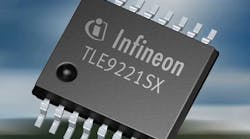Automobiles are hotbeds of networking activity. Multiple interfaces and buses interconnect various components and subsystems. The LIN bus handles low-speed applications such as power seats, windows, and mirrors. The CAN bus handles faster traffic for the engine, transmission, and anti-lock braking system (ABS). The FlexRay bus is now the de facto standard for high-speed deterministic applications like drive-by-wire, active suspension, adaptive cruise control, and similar time-dependent needs. Infineon’s TLE9221SX FlexRay transceiver is designed for these applications.
The FlexRay communications standard from the Industry Standards Organization (ISO) connects the various electronic control units (ECUs) now common in all vehicles. It has a maximum data rate of 10 Mbits/s and uses one or two differential unshielded twisted-pair (UTP) cables for noise cancellation. The second UTP isn’t always used but is deployed in applications for redundant, fail-safe features. FlexRay’s basic topology is a multidrop bus, but it can support star or hybrid combinations. A time division multiplexed access (TDMA) multiplexing scheme ensures precise timing of time-critical functions such as power steering, suspension and chassis control, and engine and transmission control applications.
The TLE9921SX is designed for severe noisy and hazardous environments. First, it fully complies with the current FlexRay electrical physical-layer (PHY) specification version 3.0.1. Second, it has a superior electrostatic discharge (ESD) rating of ±10 kV. Third, it has very low electromagnetic interference (EMI) and passed the severe electromagnetic compatibility (EMC) tests at the Germany-based IBEE, an independent test house for automotive certification. Finally, the device pins are fully protected against short circuits to positive or negative battery voltage levels.
The chip offers full over-temperature protection and features an integrated thermal shutdown. It comes in a 16-pin RoHS-compliant (Restrictions on Hazardous Substances) PG-SSOP package. Also, it can be easily integrated into existing designs since it can be placed on a 20-pin FlexRay transceiver footprint. The 16-pin IC is available now, and a 14-pin version is planned for 2013.
Infineon Technologies AG

